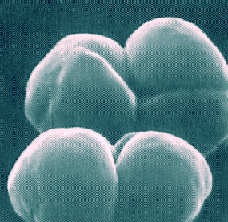Related Research Articles

Proteobacteria is a major phylum of Gram-negative bacteria. They include a wide variety of pathogenic genera, such as Escherichia, Salmonella, Vibrio, Helicobacter, Yersinia, Legionellales, and many others. Others are free-living (nonparasitic) and include many of the bacteria responsible for nitrogen fixation.

Thiomargarita namibiensis is a Gram-negative coccoid Proteobacterium, found in the ocean sediments of the continental shelf of Namibia. It is the largest bacterium ever discovered, as a rule 0.1–0.3 mm (100–300 μm) in diameter, but sometimes attaining 0.75 mm (750 μm). Cells of Thiomargarita namibiensis are large enough to be visible to the naked eye. Although the species holds the record for the largest bacterium, Epulopiscium fishelsoni – previously discovered in the gut of surgeonfish – grows slightly longer, but narrower.
The Desulfobacteraceae are a family of Proteobacteria. They are reducing sulfates to sulfides to obtain energy and are strictly anaerobic. They have a respiratory and fermentative type of metabolism. Some species are chemolithotrophic and use inorganic materials to obtain energy and use hydrogen as their electron donor.
Sulfur-reducing bacteria are microorganisms able to reduce elemental sulfur (S0) to hydrogen sulfide (H2S). These microbes use inorganic sulfur compounds as electron acceptors to sustain several activities such as respiration, conserving energy and growth, in absence of oxygen. The final product or these processes, sulfide, has a considerable influence on the chemistry of the environment and, in addition, is used as electron donor for a large variety of microbial metabolisms. Several types of bacteria and many non-methanogenic archaea can reduce sulfur.Microbial sulfur reduction was already shown in early studies, which highlighted the first proof of S0 reduction in a vibrioid bacterium from mud, with sulfur as electron acceptor and H2 as electron donor. The first pure cultured species of sulfur-reducing bacteria, Desulfuromonas acetoxidans, was discovered in 1976 and described by Pfennig Norbert and Biebel Hanno as an anaerobic sulfur-reducing and acetate-oxidizing bacterium, not able to reduce sulfate. Only few taxa are true sulfur-reducing bacteria, using sulfur reduction as the only or main catabolic reaction. Normally, they couple this reaction with the oxidation of acetate, succinate or other organic compounds.In general, sulfate-reducing bacteria, are able to use both sulfate and elemental sulfur as electron acceptors. Thanks to its abundancy and thermodynamic stability, sulfate is the most studied electron acceptor for anaerobic respiration that involves sulfur compounds. Elemental sulfur, however, is very abundant and important, especially in deep-sea hydrothermal vents, hot springs and other extreme environments, making its isolation more difficult. Some bacteria – such as Proteus, Campylobacter, Pseudomonas and Salmonella – have the ability to reduce sulfur, but can also use oxygen and other terminal electron acceptors.

In taxonomy, the Methanosarcinales are an order of the Methanomicrobia.
The Chloroflexi or Chlorobacteria are a phylum of bacteria containing isolates with a diversity of phenotypes, including members that are aerobic thermophiles, which use oxygen and grow well in high temperatures; anoxygenic phototrophs, which use light for photosynthesis ; and anaerobic halorespirers, which uses halogenated organics as electron acceptors.
Dehalococcoides is a class of Chloroflexi, a phylum of Bacteria. It is also known as the DHC group.
Desulfosporosinus is a genus of strictly anaerobic, sulfate-reducing bacteria, often found in soil.
"Candidatus Scalindua" is a bacterial genus, and a proposed member of the order Planctomycetes. These bacteria lack peptidoglycan in their cell wall and have a compartmentalized cytoplasm. They are ammonium oxidizing bacteria found in marine environments.
Muricauda ruestringensis is a bacterium. It is a facultatively anaerobic, appendaged bacterium first isolated from the North Sea. Its nearest relative is Zobellia uliginosa. The type strain is strain B1T.
Desulfomonile tiedjei is a bacterium. It is anaerobic, dehalogenating, sulfate-reducing, Gram-negative, non-motile, non-spore-forming and rod-shaped. Its type strain is DCB-1.
Desulfitobacterium hafniense is a species of gram positive bacteria, its type strain is DCB-2T..
Rhodoferax is a genus of Betaproteobacteria belonging to the purple nonsulfur bacteriarophic. Originally, Rhodoferax species were included in the genus Rhodocyclus as the Rhodocyclus gelatinous-like group. The genus Rhodoferax was first proposed in 1991 to accommodate the taxonomic and phylogenetic discrepancies arising from its inclusion in the genus Rhodocyclus. Rhodoferax currently comprises four described species: R. fermentans, R. antarcticus, R. ferrireducens, and R. saidenbachensis. R. ferrireducens, lacks the typical phototrophic character common to two other Rhodoferax species. This difference has led researchers to propose the creation of a new genus, Albidoferax, to accommodate this divergent species. The genus name was later corrected to Albidiferax. Based on geno- and phenotypical characteristics, A. ferrireducens was reclassified in the genus Rhodoferax in 2014. R. saidenbachensis, a second non-phototrophic species of the genus Rhodoferax was described by Kaden et al. in 2014.
Desulfitobacterium metallireducens is an anaerobic bacterium that couples growth to the reduction of metals and humic acids as well as chlorinated compounds. Its type strain is 853-15A(T). It was first isolated from a uranium-contaminated aquifer sediment.
Muricauda is a bacterial genus from the family of Flavobacteriaceae.
Marinobacter santoriniensis is a Gram-negative, facultatively anaerobic, non-spore-forming and motile bacterium from the genus of Marinobacter which has been isolated from hydrothermal sediments in Santorini in Greece. Marinobacter santoriniensis can metabolize arsenate and arsenite.
Desulfomonile is a Gram negative, strict anaerobe and non-motile bacterial genus from the family of Syntrophaceae. Desulfomonile bacteria can reduce sulfur oxyanions to H2S.
Altererythrobacter is a bacterial genus from the family of Erythrobacteraceae.
Neptunomonas is an anaerobic and rod-shaped genus from the family of Oceanospirillaceae.
Caldanaerobius zeae is a Gram-positive thermophilic, anaerobic, non-spore-forming bacterium from the genus of Caldanaerobius which has been isolated from organic waste leachate in Hoopeston in the United States.
References
- ↑ Sun B, Cole JR, Tiedje JM (March 2001). "Desulfomonile limimaris sp. nov., an anaerobic dehalogenating bacterium from marine sediments". International Journal of Systematic and Evolutionary Microbiology . 51 (Pt 2): 365–71. doi:10.1099/00207713-51-2-365. PMID 11321081 . Retrieved 2013-07-25.